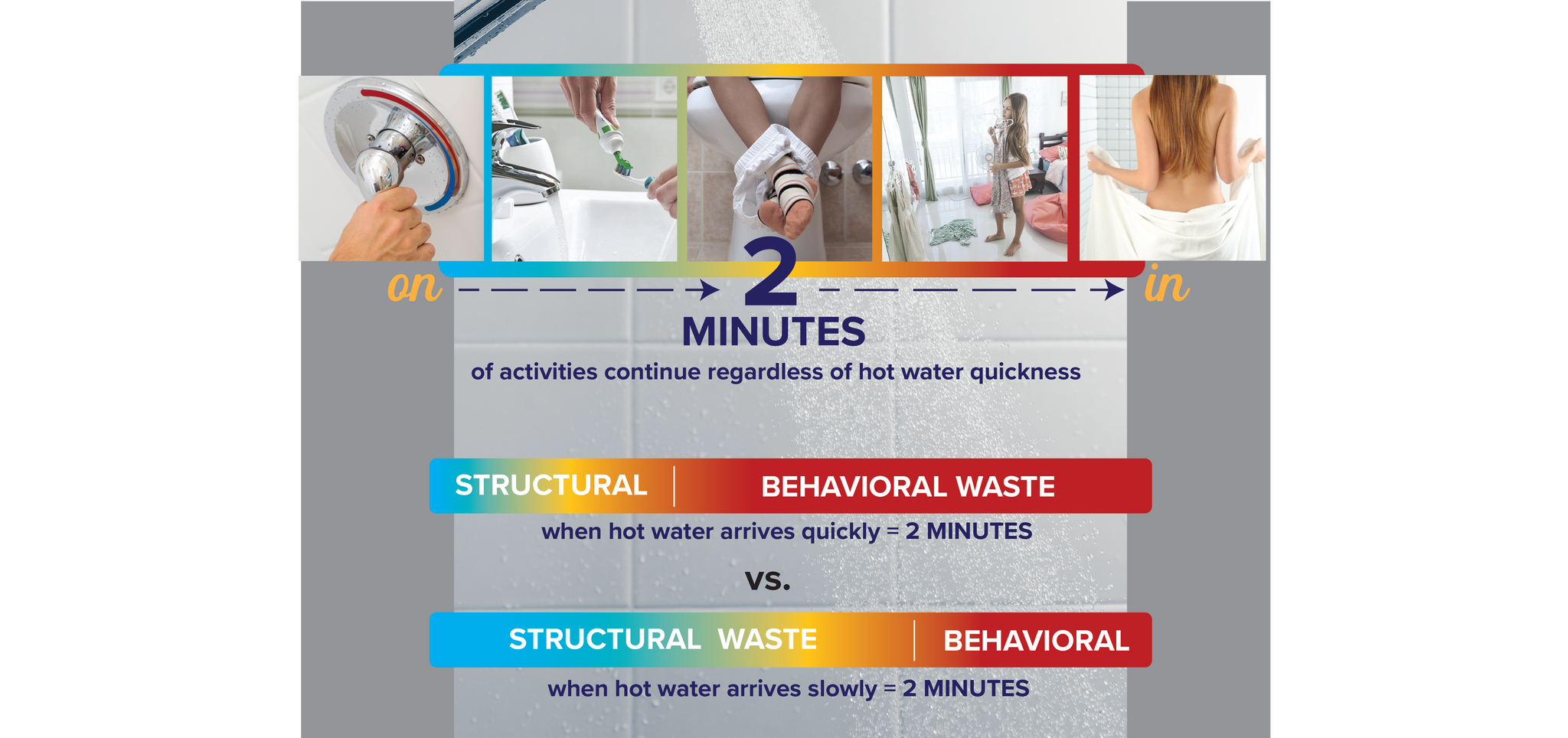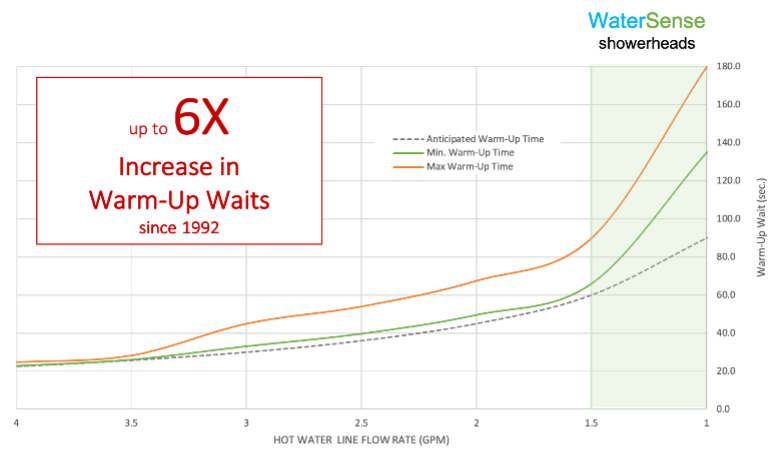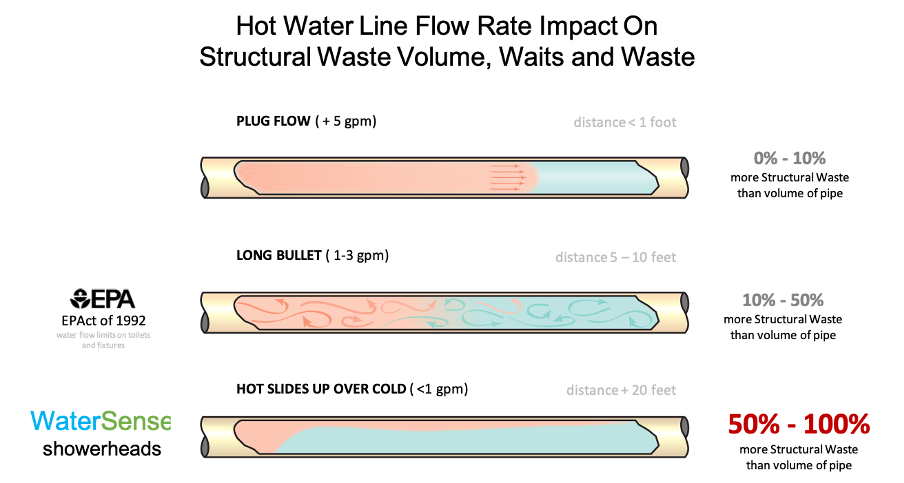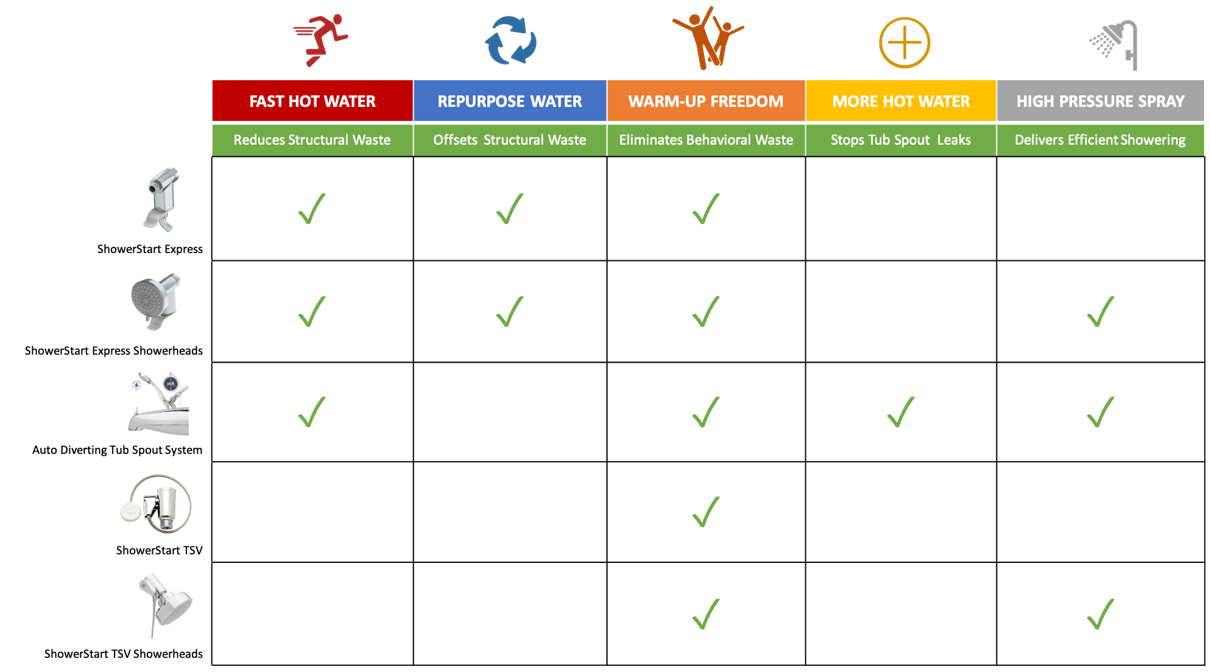is the amount water (and heat energy) that runs down the drain before showering actually begins. It's on the rise, with three primary factors contributing to its growth:
1. LONGER DISTANCES BETWEEN WATER HEATER & SHOWER:
Home sizes are increasing & plumbing runs are becoming longer.
2. LOWER SHOWERHEAD FLOW RATES:
Showerhead flows have decreased by 28% since 1992.
3. BATHER BEHAVIOR:
More than 75% of bathers turn-on the shower and leave to do something else while waiting for hot water to arrive.
Lawrence Berkeley National Laboratory (LBNL), under the direction of Jim Lutz, has a history of analyzing the water and energy waste associated with Warm-Up Waste and has published two known papers on the topic, Feasibility Study and Roadmap to Improve Residential Hot Water Distribution Systemsand Water and Energy Wasted During Residential Shower Events. In the first paper, Lutz used a mathematical formula to analyze more than 26,000 shower events within the REUWS 1999 database and surmised that approximately 20% of the total volume of water used for showering was Warm-Up Waste. The second paper, a field study designed by Lutz, concluded that the average volume of water consumed by Warm-Up Waste was closer to 30% of the total shower volume.
Independent research contained in a Pilot Study For A Thermostatic Shower Restriction Valve by Cadmus on behalf of PPL Electric indicates bathers are spending approximately two minutes away from the shower during Warm-Up. Given that the average shower lasts~ 8 minutes, this data aligns very well with the conclusions of Lutz from Lawrence Berkeley National Lab.
In total, about 2 minutes or 25% of a shower’s water and energy volume are consumed by Warm-Up Waste.
The hot water that inadvertently runs down the drain before someone actually begins showering is called Behavioral Waste. It’s produced as a side effect of using one’s time conveniently and efficiently while waiting for hot water to arrive. Because it often takes a long time for hot water to reach the shower, bathers turn-on the water and then leave to do something else while waiting for the shower to become warm. Popular activities include brushing teeth, using the toilet, shaving, picking out clothes, making the bed…

Research conducted by Evolve Technologies in Disaggregating Residential Shower Warm-Up Waste: An Understanding and Quantification of Behavioral Waste Based On Data From Lawrence Berkeley National Labindicates that bathers’ often combine multiple activities to create a consistent Warm-Up Routine. For example, one may have a habit of turning-on the shower, using the toilet, brushing teeth and grabbing a towel before returning to the shower. The length of the Warm-Up Routine typically exceeds the time it takes to purge the Structural Waste from the hotwater line. As such, it’s theWarm-Up Routine, stimulated by the initial presence of Structural Waste, that ultimately determines the time and volume of Warm-Up Waste.
It doesn't take much of a hot water wait (Structural Waste) to stimulate the human behavior resulting in the development of a Warm-Up Routine and its corresponding Warm-Up Waste. Lawrence Berkeley National Lab field data presented in Disaggregating Residential Shower Warm-Up Waste indicates that hot water waits as little as 20 seconds encourage bathers to turn-in the shower and then leave to do something else while waiting for hot water to arrive.
Warm-Up Waste is treated as a constant, as it is set by a pattern of behavior keeping the bather away from the shower longer than it takes for hot water to arrive. As previously indicated, Warm-Up Waste lasts approximately 2 minutes on average and consumes 25% of the shower's water and energy volume. Therefore, the Structural Waste and Behavioral Waste portions within the Warm-Up Waste inherently change based on how quickly hot water arrives.
Fast hot water decreases the size of Structural Waste portion and increases the size of the Behavioral Waste portion within the Warm-Up Waste volume. Slow hot water increases the size of the Structural Waste portion and decreases the size of the Behavioral Waste portion within the Warm-Up Waste Volume.
The impact on hot water waits imposed by lower flow rate showerheads is exponential, not linear due to increased thermal losses. As a result, flow rate decreases for water conservation efforts actually increase the volume of Structural Waste that must be purged before hot water arrives. The effect is a 50% - 100% increase in the actual volume of Structural Waste that must be removed.

The federal government first began regulating showerhead flow rates in 1992 by passing the Energy Policy Act. It, among other things, limited showerhead flow rates to a maximum of 2.5pgm. Before then, showerheads were unregulated and could easily consume 3-5gallons per minute depending on a home’s water pressure.
2010 introduced the first WaterSense specification for showerheads. It limited showerhead flow rates to a maximum of 2.0 gpm and mandated minimum performance thresholds for both spray force and spray coverage. Its objective was to stimulate savings greater than the federal 2.5 gpm by ensuring bathers received a high-quality, yet more efficient, shower experience.
In 2018, the California Energy Commission codified new Title 20 Water Efficiency standards mandating maximum showerhead flow rates of 1.8 gpm. Given the influence and population size of California, 1.8 gpm showerheads have now become the defacto national standard for all showerheads sold at the nation’s largest brick and mortar retailers including, but not limited to Costco, Home Depot, Lowe’s, Target and Walmart.
At the same time, the nation’s largest utility-based water and energy efficiency programs have adopted even lower maximum shower head flow rates in a continual effort to stay ahead of the rapidly declining market baseline. As a result, today’s utility program showerheads are generally standardized around 1.5 gpm showerheads and they are beginning to migrate to flow’s as low as 1.25 gpm.
It’s easy to understand that reductions in showerhead flow rates from as high as 5 gpm to as low as 1.25 gpm would increase hot water waits. After all, it’s logical to assume, for example,that hot water waits for a 1.5 gpm showerhead would be 2X those for a 3.0 gpm showerhead. However, the actual impact of lower flow rates on hot water waits is much greater than believed. This is due to an increased thermal loss associated with slow moving hot water as it journeys from the water heater to the shower.
Research presented by John Koeller in Evaluation of Potential Best Management Practices -Residential Hot Water Distribution,indicates the impact on hot water waits imposed by lower flow rate showerheads is exponential, not linear due to these increased thermal losses. As a result, flow rates of 1 gpm or less on the hot water line,a common occurrence with WaterSense rated shower heads, increases the volume of Structural Waste that must be purged before hot water arrives. The effect is a50% to 100% increase in the actual volume of Structural Waste that must be removed. In other words, bathers now have to remove more non-bathing temperature water than the volume of water residing in the hot water line. The thermal losses of slow-moving hot water create an incremental volume of lukewarm water (Structural Waste) that must also be removed before bathing temperature water arrives. The result? In many cases today’s hot water waits (Warm-Up Waits) are up to 6X longer than they were in the early 90’s, and the only thing that changed in the home was the installation of water and energy efficient showerheads.

Increased Structural Waste instigates and encourages increased Behavioral Waste, and the Warm-Up Waste problem, as well as the frustration and inconvenience resulting from longer hot water waits, grows worse. It’s a downward cycle that inadvertently promotes growing water and energy waste.
Due to the fact that Warm-Up Waste is instigated by plumbing structure, it is a difficult problem to solve. Relocating water heaters, rerouting plumbing lines, installing hot water re-circulation loops or adding retrofit on-demand hot water pumps are generally not cost effective or practical solutions for improving water and energy efficiency by reducing hot water waits.
The challenge of solving the Warm-Up Waste problem grows even bigger once the human behavior factor is considered. As previously identified, waits as little as 20 seconds are long enough to prompt bathers to turn-on the shower and then leave to do something else while waiting for hot water to arrive. And, it’s very difficult, if not impossible to implement structural plumbing changes and enhancements that can consistently deliver hot water in less than 20 seconds.
There are new products that innovatively address all or part of the Warm-Up Waste problem and they do so while adding both comfort and convenience to get-ready-routines. These inexpensive and innovative measures, depending on their particular feature sets eliminate all or the majority of Warm-Up Waste by leveraging the following comfort and convenience-based benefits:
Deliver Fast Hot Water – Reduce Structural Waste by mitigating thermal losses as hot water travels to showerhead
Repurpose Water – Offset Residual Structural Waste by capturing and utilizing non-bathing cold water for other purposes
Stop the Hot Water Waste – Eliminate Behavioral Waste by thermostatically stopping flow when hot water arrives.
The simplest and most convenient method of Reducing Structural waste is delivering Fast Hot Water. This is most easily accomplished by bypassing the flow restricted showerhead as the cold water in the hot water line is being purged. There are two methods for accomplishing this.
Tub Spout Warm-Up: The Structural Waste is purged at 5 gpm through the tub spout, and hot water,once it arrives, is diverted to the showerhead.
Showerhead With Purge Port Warm-Up: The Structural Waste is purged at 5 gpm though an unrestricted purge-port integrated into a showerhead.
In both Warm-Up types, Offsetting Residual Structural Waste is easily achieved by collecting the non-bathing temperature water in a receptacle, such as a bucket or watering can, and repurposing it for home use. Examples include watering plants, hydrating pets, doing laundry, cleaning or even flushing toilets.
However, neither Fast Hot Water or Repurposing Water address the Behavioral aspect of Warm-Up Waste. And as previously mentioned, waits as little as 20 seconds are simply too long to encourage bathers to change their habits and remain by the shower while waiting for it to become warm. The solution? A thermostatic shut-off valve (TSV) integrated into the tub spout or showerhead that senses hot water arrival and automatically, yet temporarily, shuts off the flow until bathers return and begin showering.
This core Behavioral Waste eliminating technology, ShowerStart®, developed and patented by Evolve Technologies has been installed in more than 2.5 million homes over the past several years and has been awarded numerous US and international patents.
A new ShowerStart enhancement, capable of delivering Fast Hot Water, by purging Structural Waste through an Express Port at rates up to 5 gpm and then facilitating the Repurposing of that Water has been announced. Called ShowerStart Express it Reduces Structural Waste, Offsets the Residual Structural Waste and eliminates Behavioral Waste.
Consumers gain the comfort and convenience benefits of Fast Hot Water, Repurposing Water and Warm-Up Freedom along with reduced water and energy costs. Utilities gain a simple, cost effective and consumer friendly solution for effortlessly, yet significantly, increasing a shower’s water and energy efficiency.

With Evolve’s ShowerStart Express & ShowerStart Technology the inconvenience and inefficiency of Warm-Up Waste is a relic of the past and increased comfort is the hallmark of your bathing future. We offer a wide variety of cost effective, convenience based, water and energy efficiency measures to meet your specific energy efficiency and weatherization program needs. Contact us to learn more.